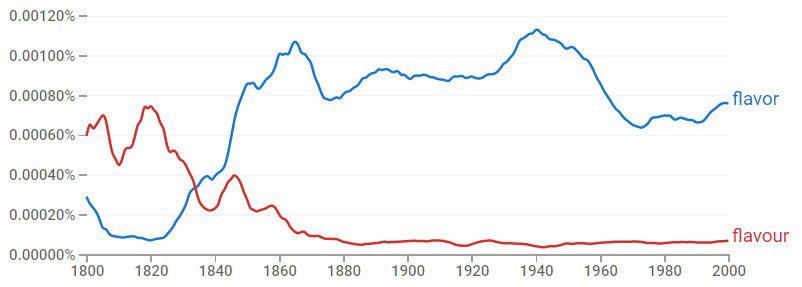Flavor and flavour are different spellings of the same word. Flavor is the preferred spelling in the United States, while flavour is the preferred spelling throughout the rest of the English-speaking world. The preference extends to all derivatives; American English has flavored, flavoring, flavorful, etc., while the other main varieties of English have flavoured, flavouring, flavourful, etc.
Though flavor has become the American spelling, it is not new. Examples of its use are easily found in British texts from the 19th century and earlier. The modern British spelling was not definitively settled until around 1800, which was around the same time that influential American educators and lexicographers began pushing the simpler flavor.
The adoption of -or spellings in place of -our ones is one of the earliest post-independence developments in American English. Many other developments didn’t come about until the second half of the 19th century and later, but the adoption of spellings such as flavor, labor, and harbor occurred in the early 19th century. The ngram below, which graphs the use of flavor and flavour in American books published from 1800 to 2019, suggests that flavor became the preferred spelling around 1840:

The ngrams for harbor/harbour, labor/labour, and many other –or/-our words look much like this one.
Examples
Flavour, as used below, is the more common spelling outside the U.S.:
But it is far better to concentrate on what’s growing in our herb gardens and avoid dried herbs if you can – their dusty flavours barely echo their origins. [Telegraph]
I loved the depth of flavour and saltiness it gave the chicken and I’ve been a fan of soy sauce ever since. [Times Colonist (Canada)]
Cooks love shallots because they have a mild taste that combines the flavour of a sweet onion with a touch of garlic. [Stuff.co.nz]
And flavor is standard in U.S. English:
Of the difference between a bright, raw, juicy slice of tomato and the dark, chewy flavor of tomato paste. [Salon]
Pimenton comes in three flavors: sweet, bittersweet and hot. [Washington Post]
It is difficult to convey how stimulating it is to crunch through such a kaleidoscope of flavors, tempered by a neutral mass of bread and cheese. [Wall Street Journal]
